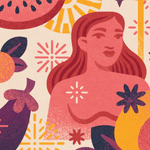5 Sex Tips from Canadians Living with Disabilities

Four Canadians with disabilities share their top sex tips—because everyone deserves to have good sex.
One particular scene in the third season of Netflix’s Sex Education got the internet buzzing. It features Maeve (Emma Mackey), a teenager without disabilities, and Isaac (George Robinson), who uses a wheelchair, as they explore sex for the first time together. The scene unfolds as a masterclass: Maeve is careful and curious, asking questions about how Isaac wants to be touched. He shares where he can feel and what feels good, and confirms that, yes, he can get an erection. The couple is gentle with each other, exploratory, excited. She helps him undress, they kiss, they touch.
Even though there are more than six million individuals with disabilities in Canada alone, beautiful moments like these are a rarity on screen.
“A big misconception is that people with disabilities are asexual and don’t have sex,” says Gabriella Carafa, a Toronto-based social worker, psychotherapist, disability advocate and wheelchair user. “Because of the lack of disability-appropriate representation in the media, we don’t see disabled people as sexual beings—I don’t see myself in soap operas or reality shows—there is no me on The Bachelorette.” As a result, people with disabilities can find it difficult to imagine how a partner might see them sexually, says Carafa.
We talked to four Canadians who live with disabilities to help dispel the myths and misconceptions around sex and intimacy. Here are their top sex tips that everyone—whether you have a disability or not; are having sex with a person with a disability or not—needs to know.
Recognize that everyone deserves to have (good) sex
Before even entering the bedroom, understand that every single person is “100 percent worthy of love and pleasure,” says Dr. Loree Erickson, a Toronto-based disability and sexuality issues academic, activist and wheelchair user.
There’s a need for the world to “unlearn dominant ideas about sex and disability,” says Erickson. The reality is pleasure has levels and layers, and it looks different for everybody.
Treat masturbation as a priority
Knowing what you find pleasurable will help you guide your partner and create a safe, intimate space—and the best way to learn that is through masturbation. “Find your erogenous zones, find out what you are comfortable with alone and with assistance,” says Christine Selinger, an Alberta-based instructional designer, former Paralympic canoeist and disability educator.
Whether you have a disability or not, your body may not find pleasure in the ways you see in movies or that work for other people, and that’s perfectly OK, says Selinger. “We all have different needs and wants, and you need to know what feels good, what feels really good, and what does not feel good.” Having that information can help sex be more pleasurable and comfortable with your partner.
View this post on Instagram
Talk about sex with your partner
Open up the dialogue about what brings you pleasure and what your boundaries are, says Carafa. “It’s about developing trust.” If either person has questions about the other’s needs or disability, it’s important for them to feel safe to ask those questions.
Acknowledging the importance of these conversations can help relieve pressure and discomfort, says Williams. These conversations can also include putting other concerns on the table, whether that’s about contraception or managing sexual side effects of medication.
Know there’s no “right” way to have sex
People with chronic pain or fatigue may feel they don’t have enough energy for sex—but sex can be slow and mindful, too. “It’s helpful to redefine what sex is,” says Williams.
Depending on the disability, some people may or may not feel interior or external sensations, or may have difficulty reaching certain areas. “Sex is more than penetration, and it doesn’t have to necessarily end in an orgasm,” says Williams. There are many ways to make sex pleasurable. Various positions work better for people with different levels of mobility, heights and sizes.
But also, don’t rule out orgasms—those with spinal cord injuries can still experience them—though prolonged foreplay may be necessary (not that that’s a bad thing).
Add toys and explore your kinks
There’s a wide spectrum of adaptive sex toys that can ease and enhance the pathway to pleasure.
“I see using sex toys as a natural progression of the disabled experience,” says Selinger. For instance, the practically hands-free We-Vibe Sync can be controlled by a remote or app, the Liberator Wedge can support your body in various positions and the Hot Octopuss Pulse is a masturbation sleeve that doesn’t even require the user to be erect.
Another way to discover the best forms of pleasure for you is to explore kink culture, which can introduce you to new sexual experiences. It can also teach you how to communicate your comfort needs, says Kyisha Williams, a Toronto-based health promoter and filmmaker. To get “kinky” in the bedroom, focus on your and your partner’s sexual interests and practices—play into them, and you can heighten your intimacy. Another way to explore kink culture is through local and online communities, like FetLife, a social network for the BDSM, fetish and kink community.
Learn more
Read The Ultimate Guide to Sex and Disability by Miriam Kaufman, Cory Silverberg and Fran Odette, which is essentially a bible for those curious about sex for people with disabilities, says Selinger. Follow disability advocates Wheelchair Rapunzel and Cripping Up Sex With Eva on Instagram, recommends Carafa, as they share daily inspiration and tips on living with a disability.
Listen to the podcast Disability After Dark by disability awareness consultant Andrew Gurza, suggests Williams, and consider watching queercrip-produced pornography. “There is nothing like seeing queer disabled people relishing in their bodies and flaunting the ways they are not part of the norm while accessing their desires and fantasies,” says Erickson.




